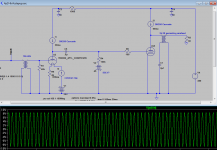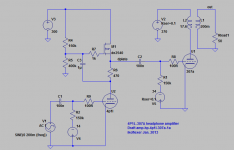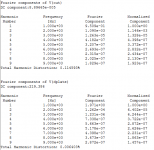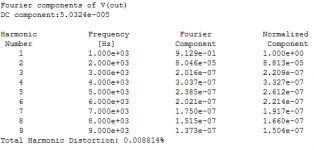Usually 4-6 weeks when I've ordered.... do you know how many time takes to build & deliver?
I've found the Edcor transformers to be bass shy, has anyone else?
I don't understand using the 300B for headphones, unless you just want to do it as a statement.
I once asked Jean Hiraga "why the 300B?" instead of some other DHT. He replied that it was a great choice for most home systems because it sounds good and has enough power for most home style speakers. There are other DHT that sound better, but they either don't have enough power for typical home systems, or require very high voltages and difficult OPTs. The 300B best fits the domestic Hi-Fi niche. It's the best "all-arounder".
So it seems to me that for a low power headphone amp, there are better choices.
I once asked Jean Hiraga "why the 300B?" instead of some other DHT. He replied that it was a great choice for most home systems because it sounds good and has enough power for most home style speakers. There are other DHT that sound better, but they either don't have enough power for typical home systems, or require very high voltages and difficult OPTs. The 300B best fits the domestic Hi-Fi niche. It's the best "all-arounder".
So it seems to me that for a low power headphone amp, there are better choices.
I haven't tried but why wouldn't it? If 1 milliwatt produces 97dB then what is 500 milliwatts going to produce? Permanent hearing loss is my guess.
Yep, I agree with what you are saying, the orthos are the real problem child that make the OPT expensive.
The edcor PCW10K-7K/300-32 has a good rep, the interesting thing about that one is Electra-Print makes a nickle core version of the same footprint for an "OEM" headamp builder (guess who) but Mr. E. refuses to sell to individuals.I would say you should get better results with a lower Ra tube than a #26.
If we don't think DC coupling is worth it, I really would lean to a parafeed, what is the disadvatage?
The Sowter 8665 parafeed isn't too many $'s, claims 2W at 50hz, 0.5W at 20hz. I think this may be fine for orthos, definately would cover all Senn's, Grados, AKG's, and Beyers.
The reason I am stressing Orthos, is because as a Headphone "geek" since the 90's I have never heard anything I like as much as these new orthos. The midrange is just something you have to experience.
If we think the 8665 is too small I could ask Sowter if they can sell the 8995 with a 38 ohm secondary.
As far as the hybrid outputs, the thing I have against them for this thread is they have been done too death, and literally you can't beat a $250 used Lyr if thats the sound you want, the lyr measures as good as what Rod's hybrid and nearly as good as Beau's Hybrid Aikido, but not as good as Alex calvalia's designs like the StackerII or EHHA, there are just more than enough of these, none sound like an SET OPT let alone DHT . The DIY incentive for hybrids is just non-motivating for me. Just buy a used EHHA or Lyr and save yourself a lot of time (and money.)
Edit. There is a "need"for 300B even GM70's, for 50 ohm HE6's, they ask for 25Vp across a 50 ohm coil (that's >300Vp-p across a primary), the AKG1000's are just as demanding. Frank Cooter (the guy who built the first all DHT headphone amp) is now using the GM70 for his ortho headphone amplifier for its linearity at high voltage swing. Again an ortho driver is more demanding for voltage than a Fostex full range speaker, its the size of the magnet and the thin membrane phsics that are working against us.
Last edited:
Usually 4-6 weeks when I've ordered.
I've found the Edcor transformers to be bass shy, has anyone else?
I didn't like shy bass
Its the core, the nickel e-print version has plenty induction and has thundering bass (its whats used in the ecp amp.) Read Designing a parafeed headphone amp
having heard it compared to my DIY single fed spud, left me craving a permalloy parafeed. But I know there are some gotcha's with parafeed (resonance) that I may not have the equipment to deal with. I've noticed there isn't a lot of parafeed info on this forum.
having heard it compared to my DIY single fed spud, left me craving a permalloy parafeed. But I know there are some gotcha's with parafeed (resonance) that I may not have the equipment to deal with. I've noticed there isn't a lot of parafeed info on this forum.
I agree. I just have the narrower goal of using the 26 with the cans I have. I think it's a 'just barely fits' end result and I'm fine with that. If I end up with ortho headphones down the road I'd probably try a 10 if I really wanted to do DHT but I'd most likely go with IDHT tubes instead.I would say you should get better results with a lower Ra tube than a #26.
As far as parafeed, once the transformer and choke (or to remove the choke interaction, CCS) are decided on then it's a matter of sizing the capacitor. Oh, how fun it is to choose the method of parafeed capacitor calculation. Then there is the excel spreadsheet on this page that is far more rigorous and most likely more predictive.
Edit. There is a "need"for 300B even GM70's, for 50 ohm HE6's, they ask for 25Vp across a 50 ohm coil (that's >300Vp-p across a primary), the AKG1000's are just as demanding. Frank Cooter (the guy who built the first all DHT headphone amp) is now using the GM70 for his ortho headphone amplifier for its linearity at high voltage swing. Again an ortho driver is more demanding for voltage than a Fostex full range speaker, its the size of the magnet and the thin membrane phsics that are working against us.
This was exactly my point earlier. Developing an amplifier that will drive ALL headphones out there is a bit utopic. A GM70 amp will look very different from a 4P1L amp. But 4P1L amp will look very similar to a 2A3 amp, and will drive MOST headphones out there, just by choosing a different output transformer.
So far I've explored in simulation a simple two stage design with the following DH driver tubes: 26, 4P1L, 3A5, and 1S4, and the following output stage tubes: 300B, 307A, 2A3, 4P1L (single and paralleled), PX4 (traced the curves from the Sofia PX4). I have tried output loads of 8, 30, 50, 100, 300 ohms. My aim was to get 1-2W relatively clean output. Don't ask for exact number, because I don't really believe the number 100%. But it's a good way to roughly compare the different tubes, at least on paper. Combine that with people's experience and you get some sort of impression and possible motivation to put effort into building a real circuit with a particular set of devices. This is where I'm at as far as this project is concerned. I have my agenda, of course, but am willing to explore ideas that others put forward as well. Help others, if that is possible.
Usually 4-6 weeks when I've ordered.
I've found the Edcor transformers to be bass shy, has anyone else?
Sure, if you buy Edcor transformers for SE choosing them by power. I used 25W transformers in 5W prototype, with great result.
Also they have naked transformers and transformers with blue bells. Naked transformers are for guitars that need to go from 80 Hz.
I don't understand using the 300B for headphones, unless you just want to do it as a statement.
I once asked Jean Hiraga "why the 300B?" instead of some other DHT. He replied that it was a great choice for most home systems because it sounds good and has enough power for most home style speakers. There are other DHT that sound better, but they either don't have enough power for typical home systems, or require very high voltages and difficult OPTs. The 300B best fits the domestic Hi-Fi niche. It's the best "all-arounder".
So it seems to me that for a low power headphone amp, there are better choices.
For low power, yes. But for some Grado that wants 2, even 6W, it is logical choice.
Grado Labs, Inc.
This was exactly my point earlier. Developing an amplifier that will drive ALL headphones out there is a bit utopic. A GM70 amp will look very different from a 4P1L amp. But 4P1L amp will look very similar to a 2A3 amp, and will drive MOST headphones out there, just by choosing a different output transformer.
So far I've explored in simulation a simple two stage design with the following DH driver tubes: 26, 4P1L, 3A5, and 1S4, and the following output stage tubes: 300B, 307A, 2A3, 4P1L (single and paralleled), PX4 (traced the curves from the Sofia PX4). I have tried output loads of 8, 30, 50, 100, 300 ohms. My aim was to get 1-2W relatively clean output. Don't ask for exact number, because I don't really believe the number 100%. But it's a good way to roughly compare the different tubes, at least on paper. Combine that with people's experience and you get some sort of impression and possible motivation to put effort into building a real circuit with a particular set of devices. This is where I'm at as far as this project is concerned. I have my agenda, of course, but am willing to explore ideas that others put forward as well. Help others, if that is possible.
I appreciate the input greatly. I have also simulated several scenarios. I think the 5W/50 ohm HE-6 are "utopia" but the 1W/38 ohm HE-500 are a more reasonable goal.
When I do the sims what I keep coming up with is the importance of low Ra.
I compare my WE417A Singlefeed Spud. I could throw a 6c45p1 or a D3A in its place and probably get nearly the same power as a 4P1l.
So with my sims I find the 2A3 an incremental step-up in power over what I have now, due to the fact that it runs at a higher plate voltage (more linear swing) and the fact that it has a much lower Ra allowing a lower turns ratio.
Unfortunately I don't necessarilly see the two stage 4P1l as much more than a few decible "better" than a spud 6c4pi. For 1 Watt with the 5k primary we need 71Vrms across the primary. Thats 200Vp-p, my sims just show that the 2A3 does a beter job with this much and we can use a 3k primary (squared relation), is that what you are seeing ?
Last edited:
funny, Bartola's site looks like DHT Rob's new site
anyway, since a real SRPP preamp is said to be optimal only when designed for a specific low impedance load, I thought it would be ideal for headamps ?
Simply because Rob is using one of my cartoons
Ale
I think the 5W/50 ohm HE-6 are "utopia" but the 1W/38 ohm HE-500 are a more reasonable goal.
I only meant that for most people an amplifier that does 5W/50 ohm and also covers all the other popular headphones is a bit utopic. See what people wrote earlier in the thread about availability of parts, but I think that the ease of building is an issue as well. Just heating the 20V/3A filament of the GM70 to headphone standards of low noise is a major challenge, even for experience builders, IMHO. It's just an opinion, so don't shoot.
Thats 200Vp-p, my sims just show that the 2A3 does a beter job with this much and we can use a 3k primary (squared relation), is that what you are seeing ?
So far I'm seeing that the 4P1L is a very good choice for the driver. In the output stage, indeed, 2A3 is one of the best, but PX4 and 307A are better. Do you think Pete Millett chose 307A and PX4 at random?
I only meant that for most people an amplifier that does 5W/50 ohm and also covers all the other popular headphones is a bit utopic. See what people wrote earlier in the thread about availability of parts, but I think that the ease of building is an issue as well. Just heating the 20V/3A filament of the GM70 to headphone standards of low noise is a major challenge, even for experience builders, IMHO. It's just an opinion, so don't shoot.
So far I'm seeing that the 4P1L is a very good choice for the driver. In the output stage, indeed, 2A3 is one of the best, but PX4 and 307A are better. Do you think Pete Millett chose 307A and PX4 at random?My sims tend to agree with his choice. That is, if we're to trust simulation at all.
I meant Utopic, meaning they are such a special case as to rule them out for our concerns. Cross them out, the HE-500 at 1W is a good headphone design. The HE-6's power requirements make it a bit of a poor design, I am considering them a singularity cross them off the list for this SET.
I agree PMillet made a good choice with the PX4 but I'm just looking at a DIY design we all can build and enjoy for years to come. We common folk can't buy PX4's. Look at the datasheet for the Chinese Sophia PX4, its gain is 2/3's of the original british tubes, I don't know what those are really but they aren't PX4's IMHO, at least Sophia is honest about it.
The 307A I agree, but those too have become unobtainium. I don't want any tube that is hard to get now, cause in a few years they will be unavailable. That leaves the 2A3, its even got a good 6.3V substitute made when Russia made good tubes: the 6c4c, great complement to the 4p1l driver.
This looks much different than where I started but I think it is an interesting alternative. All the $'s are in the iron not the tubes (iron is like gold it's an investment not an expense
Attachments
Regarding the PX4 and 307A, I agree.
Still, some people do have some 307a, so here's the draft I have, in which the 307a is biased a bit on the hot side. The thd simulation is a case scenario that's interesting to me. A relatively realistic volume level for my headphones.
Compare that with having gm-70 in the output stage. :/
The question is, would anyone ever hear the difference?
Still, some people do have some 307a, so here's the draft I have, in which the 307a is biased a bit on the hot side. The thd simulation is a case scenario that's interesting to me. A relatively realistic volume level for my headphones.
Compare that with having gm-70 in the output stage. :/
The question is, would anyone ever hear the difference?
Attachments
- Home
- Amplifiers
- Tubes / Valves
- The all DHT SET Headphone Amp



